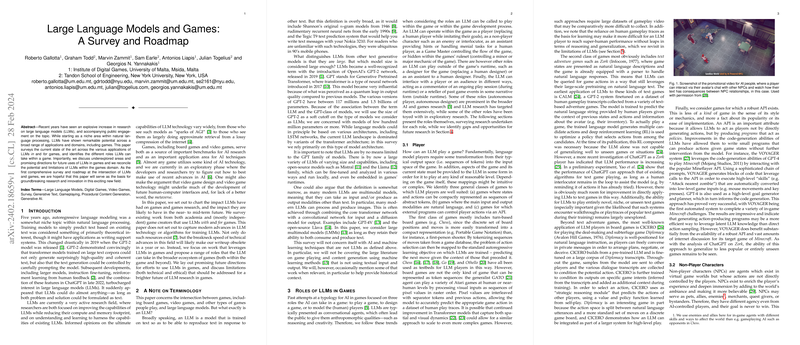Surveying the Landscape: LLMs' Roles and Impacts on Games
Introduction
The integration of LLMs into games marks a pivotal chapter in the evolution of game development and research. This comprehensive survey details the current applications, utilities, and roles of LLMs in video games, addressing both the theoretical underpinnings and practical implementations. With the rapid advancement of LLMs, including their expansion into the gaming field, understanding their capabilities, limitations, and potential ethical implications is crucial for future research directions.
Roles of LLMs in Games
LLMs assume various roles within the ecosystem of games, from players to designers, laying a foundation for innovative approaches to game interaction and creation. These roles can be broadly categorized into:
- Players: LLMs have demonstrated aptitude in playing both turn-based and real-time games, showing potential for reaching or even surpassing human performance levels.
- Non-Player Characters (NPCs): By driving dynamic, contextually appropriate dialogues, LLMs enhance the realism and depth of NPC interactions, enriching the player's experience.
- Player Assistants: As an untapped area, the utilization of LLMs as player assistants holds promise for providing gameplay tips, guiding narratives, or managing game mechanics on the player’s behalf.
- Commentators/Retellers: LLMs have the capability to narratively recount gameplay events, offering a novel way to engage audiences or provide players with reflective summaries of in-game actions.
- Game Master: Beyond digital confines, LLMs also present opportunities in tabletop games, facilitating narrative progression and management of game dynamics in real-time.
- Game Mechanic: Through generating content or driving game mechanics with text-based inputs, LLMs introduce unique gameplay elements that can continually evolve.
- Automated Designer and Design Assistant: From generating game levels to assisting in the creative process, LLMs serve both as generators of game content and collaborators in the design process, pushing the boundaries of traditional game development.
Future Applications and Research Directions
While the existing applications of LLMs in games are broad, several areas remain relatively underexplored, offering fertile ground for future research:
- Design Assistance: Bridging the gap between conceptual and procedural support, there exists potential for LLMs to play a more collaborative role in the game design process.
- Player Assistance: The conceptualization and implementation of LLM-driven player assistants could significantly enhance gameplay, providing real-time support, strategic advice, and content management.
- Commentary and Retelling: Expanding the use of LLMs as commentators and retellers to include streamer support and audience engagement opens new avenues for interactive entertainment.
- Player Modeling: Addressing one of the less explored areas, applying LLMs for modeling player behavior and experiences could revolutionize personalized gameplay and adaptive game design.
Limitations and Ethical Concerns
Despite their potential, LLMs introduce challenges related to hallucinations, factual inaccuracies, context retention, and user intent capture. Furthermore, ethical concerns regarding sustainability, copyright, explainability, and biases necessitate careful consideration and mitigation strategies to ensure responsible use.
Conclusions
The intersection of LLMs and games presents an exciting frontier with the promise of transforming game experiences, development processes, and player engagement. By addressing technical and ethical challenges, future developments in LLM applications have the potential to enrich the gaming landscape, fostering innovation and inclusivity in interactive digital entertainment.
